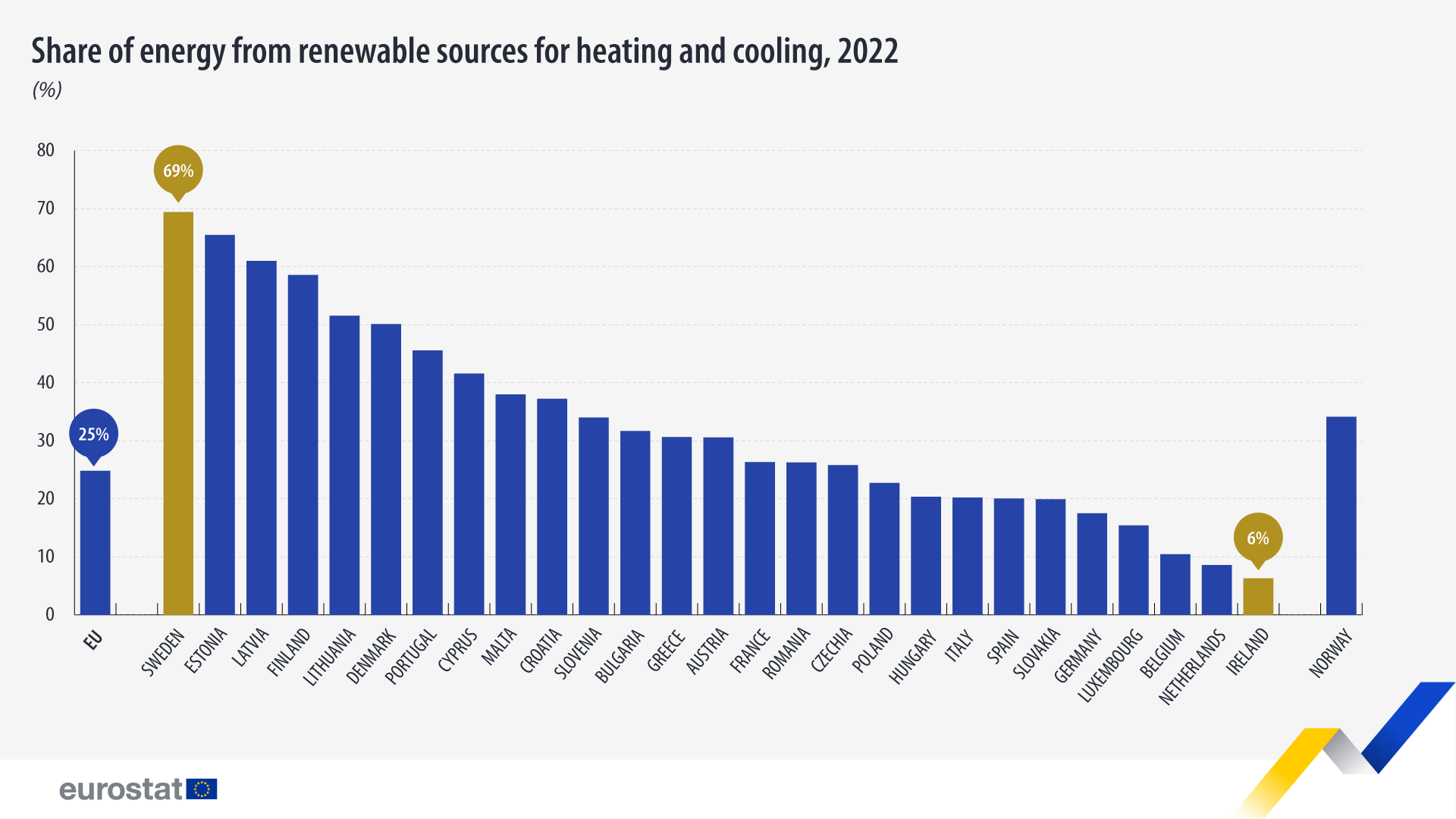Renewable energy for heating & cooling up to 25% in 2022

Energy for heating and cooling makes up around half of the EU’s total gross final energy consumption. In 2022, the share of energy from renewables in heating and cooling continued to rise, with the EU average standing at 24.8%, up 1.8 percentage points (pp) from 2021 (23.0%).
Source dataset: nrg_in_ren
Sweden led the way when it came to renewables in heating and cooling, with a 69.3% share, followed by Estonia (65.4%). Both countries use mostly biomass and heat pumps. They are followed by Latvia (61.0%), which relies mostly on biomass.
In contrast, the lowest shares of renewable sources for heating and cooling were recorded in Ireland (6.3%), the Netherlands (8.6%) and Belgium (10.4%).
Compared with 2021, the largest increases were recorded by Malta (+5.2 pp), Luxembourg (+2.5 pp), and Ireland (+1.4 pp). On the other end of the scale, decreases were registered in Austria (-2.4 pp), Slovenia (-1.2 pp), and Cyprus (-1.0 pp).
In absolute terms, the gross final consumption of renewable energy for heating and cooling purposes in the EU has gradually increased over time, mostly due to the contribution of biomass and heat pumps. In the span of 10 years, the average share of energy from renewables for heating and cooling grew from 18.6% to 24.8% (+6.2pp). However, a major push is required to meet the new targets introduced by the EU Directive 2023/2413 of 18 October 2023 on the promotion of the use of energy from renewable sources (RED III). This Directive requires EU countries to increase their annual average share of renewables in heating and cooling by at least 0.8 pp from 2021 to 2025 and by at least 1.1 pp from 2026 to 2030.
For more information
- Statistics Explained article on renewable energy
- Thematic section on the short assessment of renewable energy resources (SHARES)
- Thematic section on energy
- Database on energy
- Shedding light on energy in the EU 2023- interactive edition
- Visualisation tools on energy
Methodological notes:
- Renewable energy sources used for heating and cooling include solar thermal, geothermal energy, ambient heat captured by heat pumps for heating (and from 2021 onwards, renewable cooling, as per RED II), solid, liquid and gaseous biofuels, and the renewable part of waste. To avoid double counting, renewable electricity used to drive heat pumps is not accounted in the share for heating and cooling, but only in the share of renewables in electricity. Only heat produced from compliant liquid biofuels can be accounted for. From 2021 onwards (as per RED II), solid and gaseous biofuels combusted in installations above a certain threshold need to comply with sustainability and greenhouse gas emissions saving criteria.
- Data until 2020 are calculated on the basis of Directive 2009/28/EC (RED I), while data for 2021 and 2022 follow DIRECTIVE (EU) 2018/2001 of 11 December 2018 on the promotion of the use of energy from renewable sources (RED II). Due to the change in legal basis, a break in series occurs between 2020 and 2021. Readers are encouraged to analyse the differences between both Directives (RED I and RED II) as described in the point above, the energy sector, and all national specificities before drawing any conclusions by comparing 2021 and 2022 with previous time series. The SHARES Manual provides details on the methodology used for the calculation of the share of renewables.
If you have any queries, please visit our contact us page.

